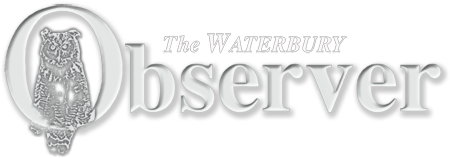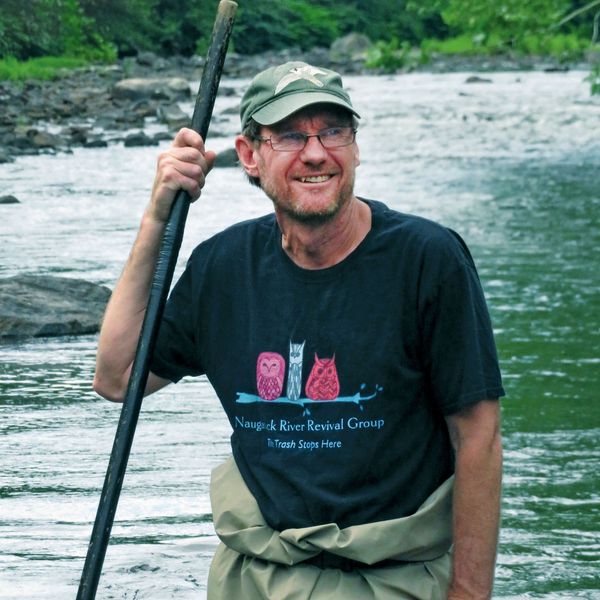(Subscribe to The Brass File to get it e-mailed free to your in-box by clicking on the link at the bottom of this page. Thank you.)
Story By John Murray
Kevin Zak’s relentless work to improve the quality of the Naugatuck River in Connecticut has evolved from trash clean ups, to organizing kayak and canoe races, to forming a 501 c-3, to inspiring a greenway through Waterbury, to testifying for the river at the State Legislature, to wading through pools of dead fish and fecal matter to document an historic sewerage spill, to organizing and leading the annual River Brigade.
These are heady accomplishments for any environmental organization, but Zak has been a one-man band, and despite all his successes, perhaps his signature moment came when he dressed like a tree to capture rare video footage of ocean-going fish trapped at the base of the Kinneytown Dam in Seymour.
Before climbing into the tree outfit, Zak spent three years filming wildlife in and along the Naugatuck River for a feature-length documentary project. Zak filmed bald eagles battling osprey for fish, he filmed deer wading through the shallows of the river as it flowed along the Platts Mill section on the Waterbury-Naugatuck town line, he filmed beavers and snapping turtles and great blue herons, and mink scampering along an embankment. What he didn’t see was very many fish.
“If I saw two or three fish, I would get really excited,” Zak said. “But I began to wonder where all the fish were.”
Curiosity eventually led Zak to the Kinneytown Dam in Seymour.

Kevin Zak at the Kinneytown dam. |
“I plunged my camera under the water and found hundreds of fish trapped in pools at the base of the Kinneytown Dam,” Zak said. “There is a fish ladder at the dam, but it doesn’t work very well, and the fish were dying before they could get up the river and spawn. It turns out that the Kinneytown Dam is a killing machine for fish going up and down the river.”

American shad try to run up the Naugatuck River in the Spring. |
American shad, sea-run brown trout, blueback herring and eels from the Sargasso Sea had made long journeys to get to their breeding grounds, and were being thwarted by a decaying and antiquated dam used to generate a meager amount of hydro-electric power. Zak also documented Atlantic Salmon below the dam, and if these are wild fish returning from the ocean, it would be international news.
“I was stunned and excited,” Zak said, “and I began documenting what I saw.”
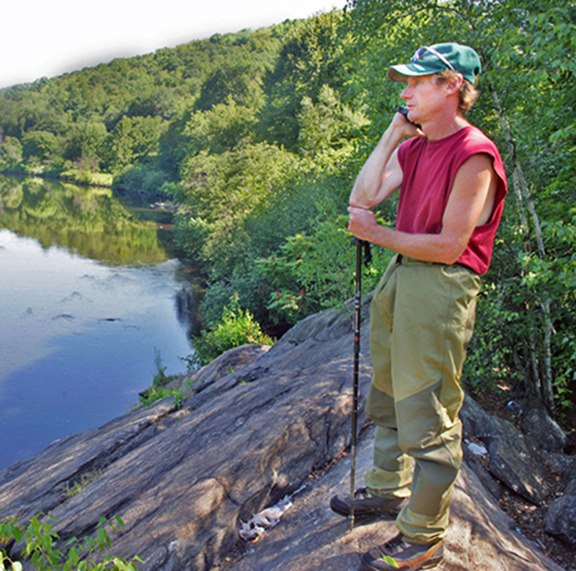
Zak’s work on the Naugatuck River has altered its history. |
Thus, began a five-year effort laser focused at documenting the drama unfolding beneath the Kinneytown Dam. During the first two years Zak was tight-lipped and secretive. He didn’t want to let anyone know what he was up to or tip his hand that he was coming after the Kinneytown Dam.
Zak would enter the river south of the dam wearing a ghillie suit (tree camouflage) to avoid detection, and film schools of fish swimming beneath the dam, or dead fish littered across the rocks. After he built up a solid block of evidence, Zak began building a coalition to fight the hydroelectric company. He got Naugatuck Mayor Pete Hess and Waterbury Mayor Neil O’Leary to back his efforts. Zak recruited state legislators up and down the Naugatuck Valley, the Naugatuck Valley Council of Governments (COG), U.S. Senator Richard Blumenthal, U.S. Senator Chris Murphy, and Save the Sound all climbed aboard his effort to restore fish runs up and down the river.
Zak and his wife, Sondra, form the Naugatuck River Revival Group and they dug into their own pockets to hire an environmental lawyer from Maine with experience fighting against power companies. Eventually COG and Save the Sound also hired lawyers, and all three organizations filed a complaint against Hydroland with the Federal Regulatory Commission in late September asking for the company’s exemption be revoked (which would force them to reapply for a license to operate the power plant).
“We have a strong coalition opposing Hydroland,” Zak said. “After years of hard work this is now a very fluid and fast-moving situation.”
The Connecticut Department of Energy and the Environment (DEEP) is now involved, and so is the Federal Bureau of Fish and Wildlife, and the United States Department of the Interior.
Legal wrangling is taking place right now, but Zak expects movement one way or another by the end of October.
What Kevin Zak has accomplished is stunning – he has taking a flake of snow and created an avalanche – but what exactly does he want to happen?
“The dam is structurally flawed, and it would be great if it was torn down,” Zak said. “But what’s most important is that the fish ladder is updated to modern standards to allow the fish to swim up and down the river, and spawn.”
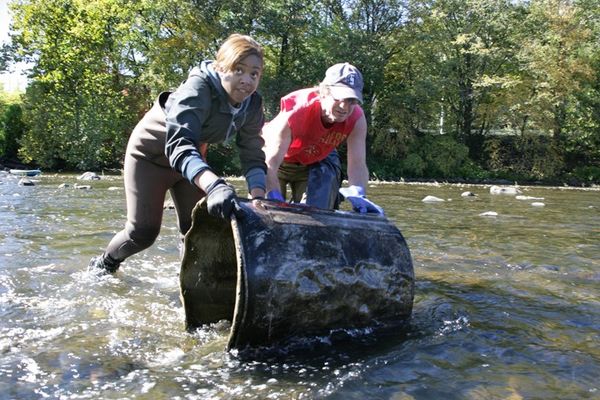
Removing industrial debris from the Naugatuck River. |
The State of Connecticut is currently updating a Naugatuck River Restoration Plan from 1997 that Zak believes will drill down on the fish passage rate at the dam right now.
“There is no standard to analyze what percentage of the fish make it up the river,” Zak said. “If there are 100 American shad at the dam, and only three make it up, that is currently acceptable. That has to change.”
Citing shad passage rates from the Connecticut River – where 75% must pass – is a standard that Zak believes must be applied to the Naugatuck River.
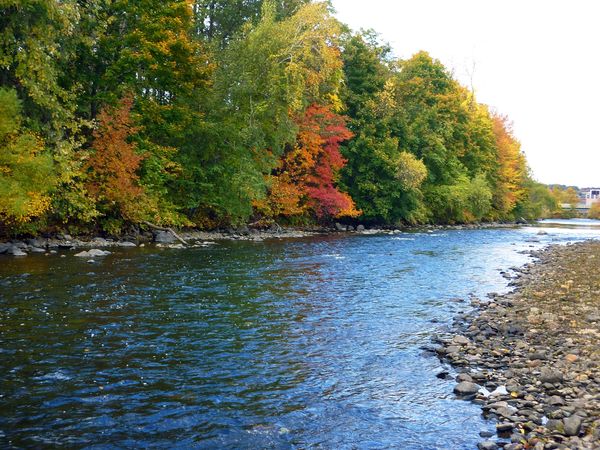
Naugatuck River flowing through the South End of Waterbury. |
As Zak uncorked legal terms and fish statistics, he was asked why anyone should really care if a shad swims past Waterbury to spawn at the headwaters of the Naugatuck River. What’s the big deal?
“Right now, we have a land-locked river that is really a lake,” Zak said. “If we remove the Kinneytown Dam, or construct a modern and efficient fish ladder, the river will run wild and free again.”
Fisherman will spend money on restaurants and hotels, property values will go up, and additional tax dollars will flow into municipal coffers.
“Solving the paradox at Kinneytown will have a positive economic and environmental impact for hundreds of years in the Naugatuck Valley,” Zak said. “And we will have returned the river back to Mother Nature.”
At the bottom of all of Kevin Zak’s e-mails is the slogan of the Naugatuck River Revival Group; ” Nothing is Impossible. Just Act.”
And with the aid of a camouflage tree suit, Zak did just that, and his tireless effort may have altered the history of the Naugatuck River for the next 300 years.
